NorthEast Radio Watch 12/15/2025: NYC Morning Shakeup
In this week’s issue… NYC morning shows exit - Carton back amidst WFAN shakeup - FM signing off in Canada - More radio centennials
Text and photos by SCOTT FYBUSH
Hamilton, Ontario is an interesting community. At the west end of Lake Ontario, it’s an important port, a steel town with centuries of history and a growing metro area of almost 800,000 people, all living in the sometimes uncomfortable shadow of the much bigger Toronto metro that adjoins it just to the east.
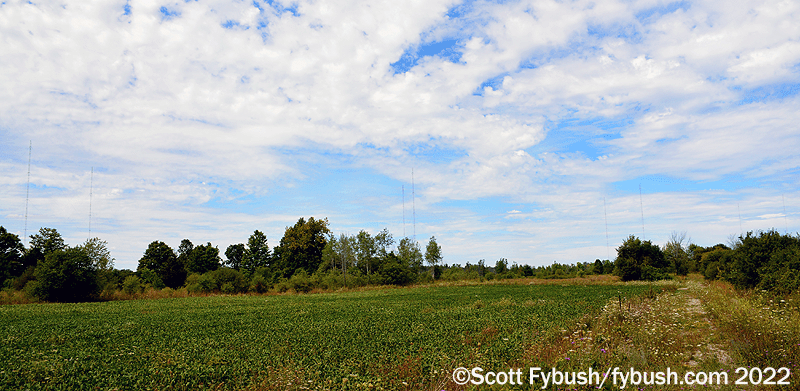
As befits an industrial city, Hamilton had its own portfolio of radio stations very early on. As we’ll see in a moment, CKOC was one of the first and oldest surviving stations in Canada back in 1922, but by 1927 it had local competition, and for an unusual reason. While CKOC refused to allow any mention on its airwaves of the debate over Prohibition in Ontario, a group of church leaders wanted their own platform. They put CFML on the air that year, sharing time with CKOC and CHCS, another early station.
Their Maple Leaf Radio Co. quickly changed calls to CHML and their station began growing into a full-service operation. By 1941, it had moved from 880 to 1010 and then to 900, where it has remained ever since – but it was running just 1000 watts from a two-tower site east of Hamilton up above the south shore of Lake Ontario. That site eventually got up to 5 kW fulltime, which sufficed through the 1960s and into the 1970s until Hamilton’s stations got into a power battle.
To get CHML all the way to 50,000 watts while protecting other Canadians and Mexico on 900 took a lot of steel: eight towers on a huge piece of land far to the northwest of Hamilton, off Highway 8 halfway between Hamilton and Cambridge. The new site, which hit the air in 1978, pushed a narrow beam of extremely high signal strength back into Hamilton and the Niagara region and even across a swath of western New York south and east of Buffalo. (The old CHML site east of Hamilton still had its transmitter building standing as late as the late 1990s, callsign and all.)
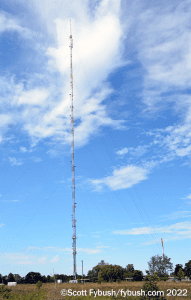
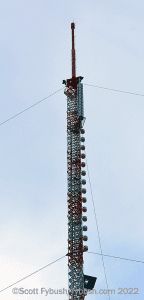

CHML was more than an AM pioneer: in 1947, it launched one of Canada’s first FM stations, CHML-FM on 94.1, running just 250 watts from the top of a downtown building. The FM station moved to 92.1 for a few years, then went off the air in the 1950s as CHML partnered with Hamilton’s other radio stations to launch CHCH-TV in 1954 from studios in an historic mansion downtown (formerly home to the Hamilton Spectator‘s short-lived CJSH-FM) and a transmitter site on the escarpment above the south shore of the lake, up east of Hamilton near Stoney Creek.
The new channel 11 aspired to reach beyond Hamilton to cover all of southern Ontario, taking advantage of its status as the region’s first independent commercial station. Until 1960, it was the only privately-owned station near Toronto, since Canada was protecting the CBC’s monopoly in cities where it had built stations first. As the new CTV network launched in the big cities, CHCH decided to go completely independent, erecting a new 1173-foot tower next to its original 500-foot tower, reaching viewers from Buffalo to Toronto and beyond.
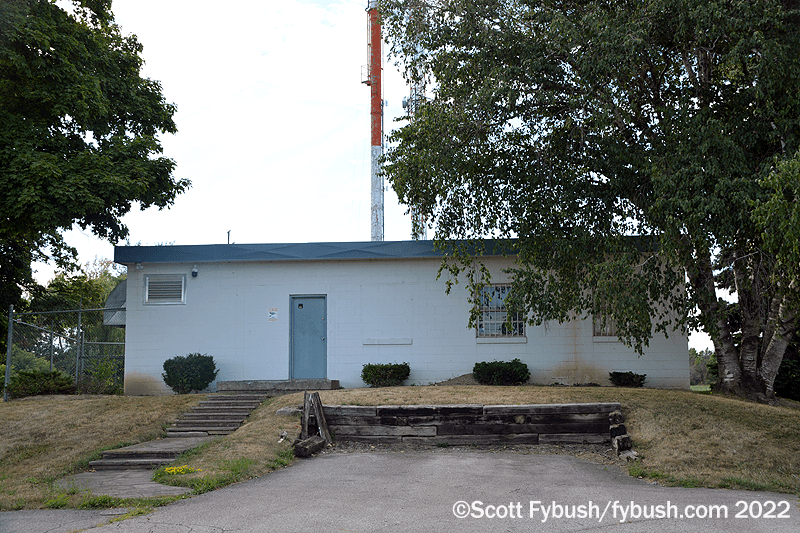
That huge tower has been a landmark for more than six decades now, with several more stations getting added to it over the years. CHML returned to FM in the early 1960s, putting the new CHML-FM on the air at 95.3 from the side of the CHCH tower (it was later CKDS, named for longtime CHML owner Ken Soble, then CJXY and is now CING), and then in 1998 a new religious station, CITS (Channel 36) came on with a side-mounted antenna.
This view of the original CHCH transmitter building may not be here much longer. As new expressways have brought a lot of development up the hill closer to this site, CHCH is planning a move to a new tower that will be located northwest of Hamilton and will also carry CING and CITS. (Hopefully we can get inside for a full tour before it goes away!)
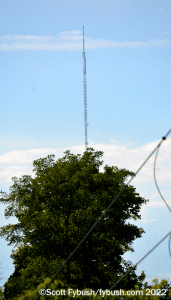

Another new FM signal came to Hamilton in 2000, on a site just east of the CHCH-TV tower near the Devil’s Punchbowl recreation area. Doug Kirk and Rae Roe built CHKX (94.7) up here with a very directional pattern to aim west into Hamilton and the Golden Horseshoe while protecting superpower WNED-FM (94.5) over in Buffalo. This station has been an HD Radio pioneer – when CHKX flipped from “Wave” smooth jazz to “Kix” country, the Wave format moved to an HD2, where it lives on today, albeit now as a simulcast of a co-owned new “Wave” station out in Vancouver, BC. (There’s another HD sub that carries co-owned oldies CHTG 92.9, from a site way south of here.)
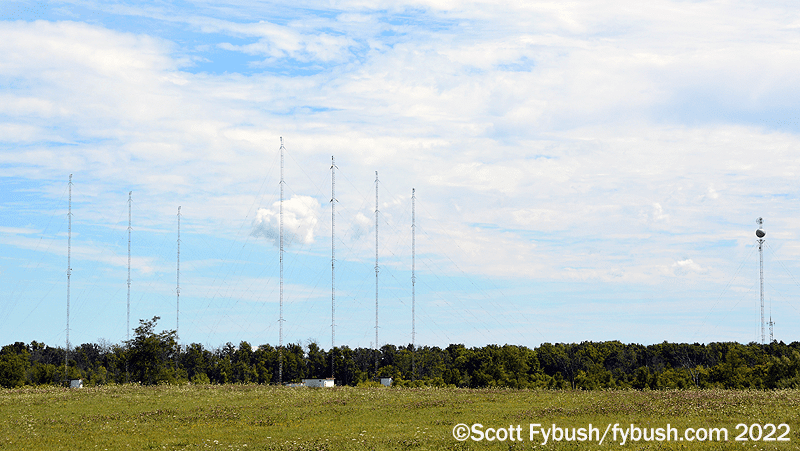
What else is south of Hamilton? Two more big AM arrays, including the one that belongs to Hamilton’s oldest radio station. As we noted earlier, CKOC started in 1922, owned by Wentworth Radio Supply, a subsidiary of Ontario Cycle (hence the “OC” in the calls) and broadcasting at low power from downtown. By 1947, CKOC had increased power to 5000 watts on 1150 from a site nine miles south of downtown at Elfrida, Ontario – and thirty years later, that site was encroached by development, sending CKOC another nine miles south to a site off Highway 56 at Blackheath. From there, ten towers pumped the AM 1150 signal, now at 50,000 watts, back into Hamilton and over Toronto as well.
CKOC was a major top-40 station until the end of AM music, hanging on with oldies before eventually flipping to sports and now to business news. Current owner Bell has tried to reduce costs out here, taking down three of the ten towers and reducing power to 20 kW at night. Will this station, which just turned 100, live to see 110?
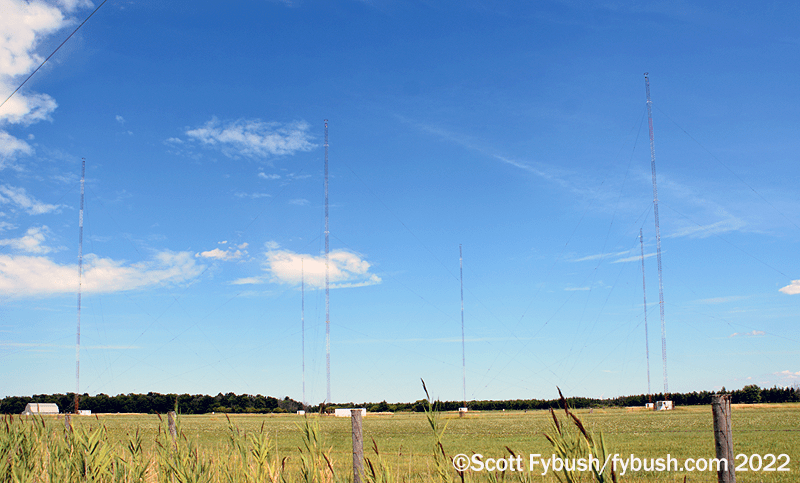
Hamilton’s youngest AM station ended up with one of the better signals in town, as it turns out. CHIQ hit the air in 1963 on 1280, running 5000 watts from a site south of Hamilton in Hannon. Four years later, it was sold to Rogers, which renamed it CHAM and installed a MOR format similar to Toronto’s CHFI; in the years that followed, 1280 became CJJD, played country for a while – and then had a stroke of luck in 1985 when the US and Canada broke down some clear channels that had been protected on opposite sides of the border. 820, which had been exclusive to WBAP in Texas, became available for use in southern Ontario, where CKMW (790 in Brampton) and CFGM (1320 in Richmond) hill applied for it, as did 820, which was by then back to the CHAM calls.
CHAM built a new six-tower site in Binbrook, just east of its old 1280 site in Hannon, and signed on here in August 1985 with 50,000 watts by day and 10,000 watts at night – and here it remains, though probably not many Hamiltonians still notice. For the last few years, Bell has parked an all-comedy format here, drawing a niche audience as “Funny 820.”
As you continue east from Hamilton back toward the US border, a funny thing happens: physically, you pass out of the Hamilton metro and into the Niagara Region, a lovely rolling landscape of wineries and small towns and canals that extends along the peninsula over toward Niagara Falls and Fort Erie. But in the last 40 years, several Toronto AM stations have built high-power directional arrays here, shooting their signals all the way back across Lake Ontario toward downtown Toronto, whose skyline is easy to view from the lakeshore and the escarpment that rises above it.
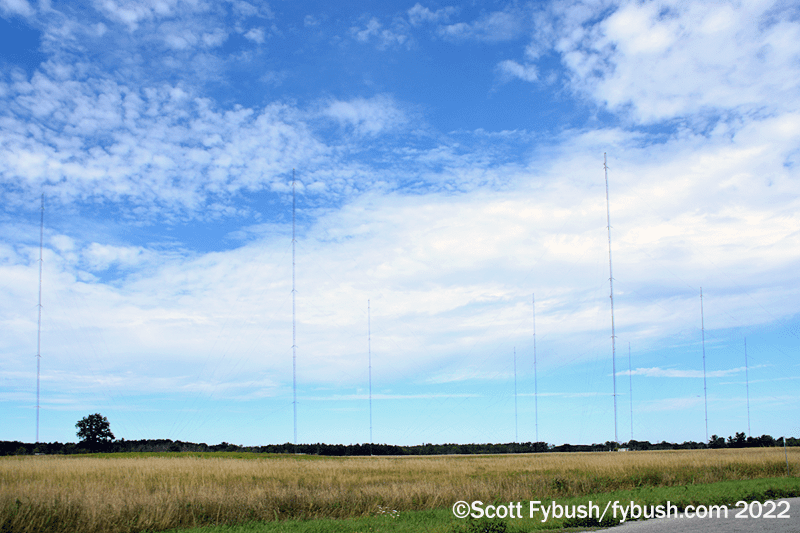
A few installments back, we took you to Toronto Island and showed you the two AMs that now call it home, CHKT 1430 and CHIN 1540. Before they had their towers over there, another AM operated from the island. CKEY was the descendant of one of Toronto’s pioneer stations, the old CKCL, which had long operated on 580, eventually from a directional antenna in Scarborough, east of Toronto. In 1962, CKEY moved from 580 to 590 and from Scarborough to Toronto Island, allowing a more expansive directional pattern to reach the growing suburbs west of Toronto – and then in 1984, it moved again, trading five towers and 10,000 watts on the island for 50,000 watts from nine towers up on the escarpment overlooking Grimsby, 30 miles across the lake from Toronto.
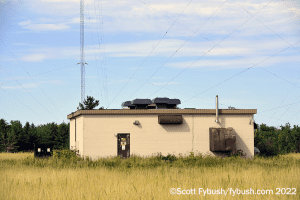

After a few years in the early 1990s as country CKYC, a swap in 1995 moved all-sports CJCL from 1430 to the 590 facility, and for almost 30 years now Toronto listeners have enjoyed the Blue Jays and sports talk coming from these nine towers over “Sportsnet 590 the FAN.”
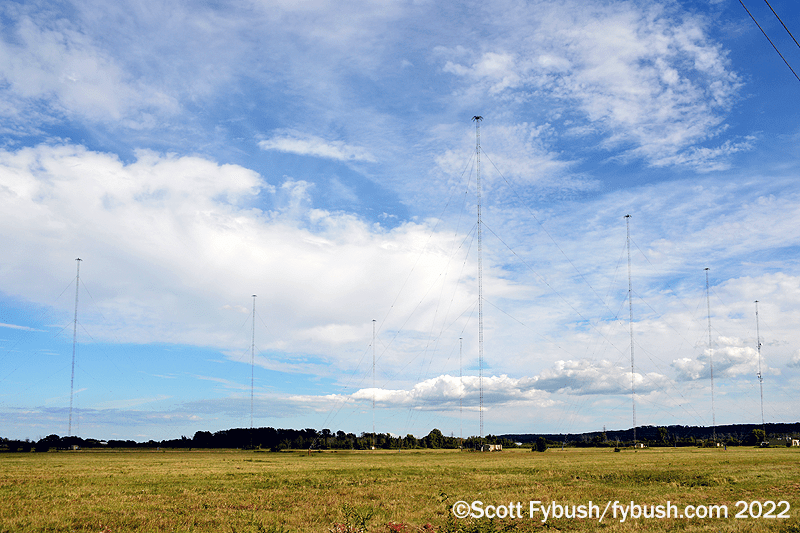
Another Toronto AM, CFTR (680), also made the move to Grimsby in 1985, trading its 13-tower site in Mississauga for eight towers along the lakeshore. At the same time, suburban country station CFGM (1320 Richmond Hill) was looking for its own signal improvement. It lost out on 820 to CHAM, but persuaded the CRTC that it could move to 640 from a Niagara Region site while still protecting nearby CKTB in St. Catharines on 610 – and by the fall of 1988, CFGM was on the air from eight big towers just south of the QEW highway in Beamsville, Ontario.
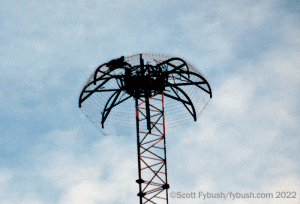
The new 50,000-watt CFGM signal did a much better job of covering Toronto, especially with those capacitance hats that increased the electrical wavelength of the 360-foot towers at Beamsville.
By then, though, the days of music on AM were waning as more Toronto listeners were tuning to FM instead of to unknown new AM frequencies like 640. The station tried valiantly – for a time, it was CHOG, “the HOG,” playing hard rock and referencing Toronto’s “Hogtown” nickname, then it experimented with various flavors of hot talk. Today, it’s part of Corus, carrying the CFIQ calls as “640 Toronto,” tied in with the Global TV newsroom.

As we announced a few weeks ago, the 2026 edition of the Tower Site Calendar will be the last.
We began publishing it 25 years ago, and the broadcast landscape is radically different now.
Radio World just ran an excellent article about us if you want to know more.
Once it’s gone, that’s it. We won’t be printing any more.
Thank you to everyone who saw our announcement and rushed to buy it. We appreciate you.
(There are some calendars from previous years if you want more of a tower photo fix — all under $5.)
But don’t wait to get this year’s Tower Site Calendar — buy it now!
We are selling the Broadcast Historian’s Calendar again this year, but we have that in an even smaller quantity — definitely don’t hesitate for that.
And visit the Fybush Media Store to check out our selection of books and videos, too!
And don’t miss a big batch of Ontario IDs next Wednesday, over at our sister site, TopHour.com!
Next week: WNAV, Annapolis MD
In this week’s issue… NYC morning shows exit - Carton back amidst WFAN shakeup - FM signing off in Canada - More radio centennials
In this week’s issue… Veteran newsman returns - Remembering NY's Leitner, RI's Jones - CT AM saved - Maine AM moves - "Indie" adds suburban signals
In this week’s issue… Scripps stations face takeover - Sinclair moves more affiliations - CT stations sold - Maine AM surrendered - Remembering WVBR's Shapiro, WABC's Morgan
In this week’s issue… CT TV legend succumbs to cancer - Remembering PA's Adams - FCC still stalled by shutdown - Pittsburgh morning host exits